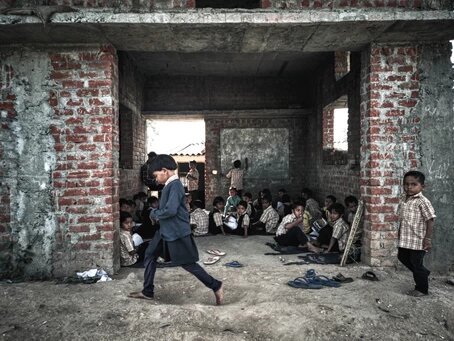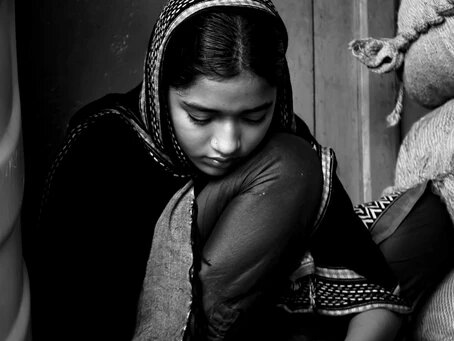The spread of the coronavirus is an unprecedented emergency that has posed several challenges in the daily lives of people and in matters of governance and administration. As the times are desperate, desperate measures have been taken to check the spread of the disease. The situation in India was dealt with a complete suspension of most services; on the 24th of March 2020, the Government of India declared a nationwide lockdown. The lockdown has made a deep impact on the lives people, especially on the working class, a huge part of the migrant labour population was uprooted from the urban centres of employment, were forced to migrate to their villages and those who remained in the cities were largely unemployed. The impact of this phenomenon on children can be assessed from the fact that 1 out of 5 of these migrants was a child.
The circumstances also exposed the dispossessed population to vicious forms of injustice and exploitation. The underprivileged children who always have been highly susceptible to malnutrition and different forms of exploitation such as child marriage, child labour, sexual abuse etc. in the “normal” situation, the present circumstances have further undermined their socio-economic status and they are in no less than a dire situation. The state of these children cannot be talked about unanimously because their social realities are different, many live in streets and do not have any families to fend for them, they earn their livelihood through, begging, rag-picking, etc., while the others belong to the families of daily wage labourers and have been left defenceless against the rise in poverty and hunger in consequence of rising unemployment. However, the problem of food is not a product of the lockdown, it has been a persisting concern in the country, as of 2017, 1.04 millionchildren died under fiveyears of age in India; the situation has only worsened by the lockdown.
There are a number of children already suffering from “Moderate or Severe Acute Malnutrition” (MAM or SAM) who are now deprived of medical care and adequate nutrition. So, in the present situation while on one hand, a considerable number of labourers and daily wage workers have become unemployed and families have lost all sources of livelihood, on the other the closure of Anganwadi, which feeds millions of children under the mid-day meal programme has deprived 95.1 millionchildren of a mid-day meal, and all activities of outreach under the Integrated Child Development Services (ICDS)came to a sudden halt on account of a massive breakdown of the supply chain of food as the movement of people, goods and services had all been suspended. According to a report ofBBC, 40 million children had been impacted belonging to the working section of the Indian population. Whilst door to door home ration delivery did take place but it could not possibly reach a major part of the distressed people. In consequence of a major section being on the move, many child deaths have been reported on these unsafe and long journeys. There are claims that street children were discriminated against during food distribution and were made to stand at the end of the queues as they were seen as the potential bearer of the virus.
However, nutrition is only one of the several concerns regarding these children,
As per a UNICEF report, 240 million children already live in “multidimensional” poverty in
South Asia and this crisis will push further 120 million children of this region into poverty. The lockdown has forced children out of schools and into child labour. As of yet, one cannot
say exactly how many children have dropped out of school in order to earn money as the schools are closed and the incorporation of children at the level of household industries is not easily identifiable but can be highly hazardous and leaves these children open to exploitation. During the lockdown, children have also been rescued by NGO’s from bonded labour. But a major threat lies in future when the usual activities resume and cheap labour will be sought after.
An unforeseen effect of the lockdown is the spike in child marriages, during March-
May, Childline India, an establishment that aids children in distress have intervened in 5,333
Marriages, given that these happened during the lockdown when all, activities, movement and events were suspended this figure should be considered exponentially high. With the easing down of the lockdown in June and July, the number of child marriages shot up showing a 17% increase in the number over the previous year. The cause of this could understandably be the economic distress in families, so marrying off a child meant one less stomach to feed.
The turn of events in the wake of Novel Corona Virus has hardly left any aspect of life,
any sector, any sections of the society untouched. But the children belonging to the working class are doubly marginalised in this situation. It is difficult to keep them from the effects of financial crises and being underage would make them very vulnerable to several kinds of exploitation.
References
Bhandare, Namita. “Covid-19 and the spike in child marriages”. Hinduatan Times. 4th September 2020.< https://www.hindustantimes.com/columns/covid-19-and-the-spike-in-child-marriages/story-aLS6zAq2Beoiyb4wyrfbdM.html>. [accessed on 9th September, 2020].
Pandey, Geeta. “Coronavirus: The children struggling to survive India’s lockdown”. BBC News Services. 11th April, 2020.https://www.bbc.com/news/world-asia-india-52210888. [accessed on 6th September 2020].
Mangal, Dr. Daya Krishnan. “India’s fight against COVID-19 and Malnutrition”.ETHealthworld.com. 21st May 2020 <https://health.economictimes.indiatimes.com/news/industry/indias-fight-against-covid-19-and-malnutrition/75858953 >.[accessed on 7th September 2020].
‘India Nutrition Profile’ Global Nutrition Report. <https://globalnutritionreport.org/resources/nutrition-profiles/asia/southern-asia/india/>. [accessed on 8th September 2020].
Bloomberg. “Coronavirus worsens India’s child-labour issue; forces children out of school to work” Financial Express. 10th August 2020. <https://www.financialexpress.com/economy/coronavirus-worsens-indias-child-labour-issue-forces-children-out-of-school-to-work/2050148/>.[accessed on 9th September 2020].




